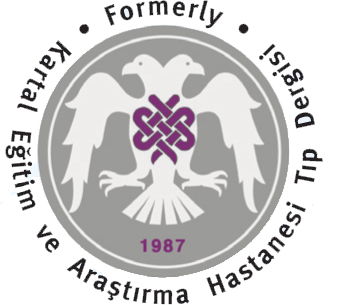Effects of High-Flow Oxygen Application on Respiratory Parameters and Compilation After Percutaneous Nephrolithotomy Operation
Ferhat Yıldız1, Fatıh Dogu Geyik2, Yucel Yuce2, Banu Cevik2, Kemal Tolga Saracoglu21Department of Anesthesiology and Reanimation, Başakşehir Çam and Sakura City Hospital, İstanbul, Türkiye2Department of Anesthesiology and Reanimation, Kartal Dr. Lütfi Kırdar City Hospital, İstanbul, Türkiye
INTRODUCTION: We aimed to compare vital parameters, arterial blood gases, postoperative recovery levels, and lung-related complications in patients with mask oxygen or high-flow nasal oxygen during the postoperative early period.
METHODS: This study included 60 patients over 18 years old with a risk score of the American Society of Anesthesiologists (ASA) IIIIII planned for percutaneous nephrolithotomy surgery. Patients were separated randomly as high-flow oxygen group (group HF, n=30) and mask oxygen group (group mask, n=30). During surgery and after wake up and after postoprative first hour O2 treatment, arterial blood gases were evaluated. Heart rate, SpO2, arterial blood pressure, and respiratory rate of two groups were compared in the postoperative early period. QoR-40 survey was used for postoperative recovery.
RESULTS: There was no statistical difference between groups in terms of demographic data. In arterial blood gas analysis at postoperative 1 h, SpO2 levels were higher and PaO2 and SaO2 increases were statistically significant in the high-flow group (p=0.01, p<0.001, p=0.03, respectively). Lower respiratory rate and pH increase were statistically significant in the high-flow group after 1-h of oxygen therapy when we compared blood gases at post-extubation versus after 1 h oxygen therapy (p<0.001 vs p=0.007, respectively). There was no statistically significant difference in PaCO2 levels. We did not see any difference in systolic diastolic blood pressure, heart rate, recovery level in postoperative 24 h, postoperative lung complications, mortality, hospital stay, and reintubation rate between the two groups.
DISCUSSION AND CONCLUSION: High-flow oxygen therapy increases oxygenation and pH in blood gases and decreases respiratory rate in the postoperative early period. There is no difference in terms of postoperative recovery and lung complications.
Perkütan Nefrolitotomi Operasyonu Sonrası Yüksek Akım Oksijen Uygulamasının Solunum Parametreleri ve Derlenme Üzerine Etkileri
Ferhat Yıldız1, Fatıh Dogu Geyik2, Yucel Yuce2, Banu Cevik2, Kemal Tolga Saracoglu21Başakşehir Çam ve Sakura Şehir Hastanesi, Anesteziyoloji ve Reanimasyon Kliniği, İstanbul, Türkiye2Kartal Dr. Lutfi Kırdar Şehir Hastanesi
GİRİŞ ve AMAÇ: Ameliyat sonrası erken dönemde maske oksijen veya yüksek akımlı nazal oksijen uygulanan hastalarda yaşamsal parametreleri, arteriyel kan gazlarını, ameliyat sonrası derlenme düzeylerini, akciğerle ilişkili komplikasyonları karşılaştırmayı amaçladık.
YÖNTEM ve GEREÇLER: Bu ileriye yönelik ve randomize çalışma, perkütan nefrolitotomi cerrahisi için planlanan ASA I-II-III risk skoruna sahip 18 yaşın üzerinde, iki cinsiyette 60 hastayı içermektedir. Hastalar rastgele ayrıldı; yüksek akımlı oksijen grubu (Grup HF, n=30), maske oksijen grubu (Grup Maskesi, n=30). Perkütan nefrolitotomi ameliyatı sırasında ve ameliyat sonrası arteriyel kan gazları değerlendirildi. Ameliyat sonrası erken dönemde iki grubun vital parametreleri (kalp hızı, SpO2, arteriyel kan basıncı, solunum hızı) karşılaştırıldı. Ameliyat sonrası iyileşme için QoR-40 anketi kullanıldı.
BULGULAR: Demografik veriler açısından gruplar arasında istatistiksel olarak fark yoktur. Ameliyat sonrası birinci saatte arteriyel kan gazı analizinde yüksek akım grubunda SpO2 düzeyleri daha yüksek, PaO2 ve SaO2 artışları istatistiksel olarak anlamlı bulundu (sırasıyla p=0.01 p<0.001 p=0.03). Ekstübasyon sonrası kan gazları ile bir saatlik oksijen tedavisinden sonraki kan gazlarını karşılaştırdığımızda, bir saatlik oksijen tedavisinden sonra yüksek akım grubunda düşük solunum hızı ve pH artışı istatistiksel olarak anlamlıdır (sırasıyla p<0.001 p=0.007). PaCO2 seviyelerinde istatistiksel olarak anlamlı bir fark yoktur. İki grup arasında sistolik diyastolik kan basıncı, kalp hızı, ameliyat sonrası 24. saatte iyileşme düzeyi, ameliyat sonrası akciğer komplikasyonları, mortalite, hastanede kalış süresi, yeniden entübasyon oranı açısından herhangi bir fark görmedik.
TARTIŞMA ve SONUÇ: Yüksek akışlı oksijen tedavisi, ameliyat sonrası erken dönemde kan gazlarında oksijenasyonu ve pHı artırır ve solunum hızını azaltır. Ameliyat sonrası iyileşme ve akciğer komplikasyonları açısından bir fark yoktur.
Manuscript Language: English



















